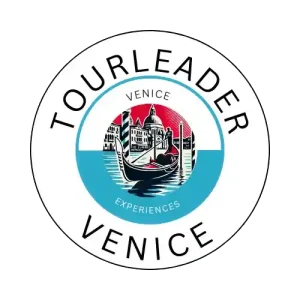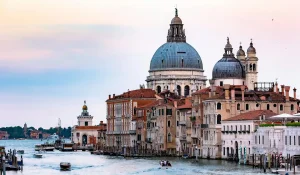St. Mark & Venice — The Evangelist, the Winged Lion, the Golden Basilica & the Sky-High Campanile
Saint Mark isn’t just a name on a square — he’s the heartbeat of Venice. His symbol, the winged lion, guards the city from façades and flagpoles; his relics rest beneath glittering domes; his story threads through Venice’s art, rituals, and identity. This is your complete guide — who St. Mark was, how he became Venice’s patron, what to look for in St. Mark’s Basilica, how to read its golden mosaics, and why the Campanile is more than a viewpoint. Come walk the lion’s path with us.
📖 Who Was St. Mark?
Saint Mark the Evangelist is traditionally credited with writing the Gospel according to Mark, the earliest and briskest of the four Gospels. Early Christian sources call him a companion, disciple, and interpreter of St. Peter; many scholars hear Peter’s voice behind Mark’s urgent prose — vivid scenes, swift dialogues, and a directness that feels almost reportage.
According to tradition, Mark preached in Alexandria (Egypt), where he founded a Christian community and eventually suffered martyrdom (1st century AD). Alexandria kept his relics, venerating him as their patron.
🦁 Why the Winged Lion?
Christian art assigns each evangelist a symbolic creature (from Ezekiel and Revelation). Mark’s is the lion, winged to signal its heavenly origin. The lion often holds a book inscribed “Pax tibi Marce, evangelista meus” (“Peace to you, Mark, my evangelist”), sometimes with a paw resting on Venice’s laws — a perfect emblem for a republic that wrapped its power in piety and pageantry.
Look closely around Venice: on wellheads, capitals, keystones, and city flags, the winged lion stands for justice, courage, and civic memory. If the book is open, the city is at peace; when shown closed or with a sword, Venice is at war. The lion’s pawprints are everywhere — once you notice them, you’ll count hundreds.
⛵ From Alexandria to the Lagoon — How St. Mark Became Venice’s Patron
In the 9th century (traditionally 828 AD), two Venetian merchants — Buono da Malamocco and Rustico da Torcello — “translated” (transferred) St. Mark’s relics from Alexandria to Venice. Medieval chroniclers say they concealed the saint’s body beneath layers of pork to dissuade Muslim customs officials from touching the cargo. The ship slipped into the lagoon, and Venice welcomed a new protector.
A first shrine was raised; later, a grander church rose beside the Doge’s Palace. In 1094, after a period of rebuilding and additions, the relics were dramatically “rediscovered” within the basilica’s masonry — seen as a divine sign that the evangelist had chosen to dwell here permanently. From then on, St. Mark was not only patron saint but also political cornerstone of the Republic.
🌹 April 25 — The Feast and the “Bòcolo”
Venetians celebrate St. Mark on April 25 by gifting loved ones a bòcolo — a red rosebud. The tradition recalls medieval legends of love and sacrifice and remains one of the city’s tender rituals. If you’re in Venice that day, you’ll see couples with roses and processions around the piazza.
⛪ St. Mark’s Basilica — A Golden Ship of Faith
Rising like an eastern dream at the edge of the square, St. Mark’s Basilica (Basilica di San Marco) is a unique fusion of Byzantine, Gothic, and Venetian craftsmanship — a “stone reliquary” for the saint and a stage for the Republic’s most sacred ceremonies. The plan follows a Greek cross with five domes that seem to float like lanterns of light.
The façade is a palimpsest of centuries: arches encrusted with marbles brought from across the Mediterranean; spolia (reused ancient fragments); sculpted saints and prophets; and, above the central portal, the celebrated Horses of St. Mark — bronze steeds once part of a triumphal quadriga, transported from Constantinople in 1204. The originals, fragile and precious, now rest in the basilica museum; replicas watch over the square from the balcony.
Inside, more than 8,000 square meters of mosaics blaze over vaults and domes — a sea of gold that earned the church its nickname: Chiesa d’Oro, the Golden Church. Beneath the high altar, in the confessio, rest the relics of St. Mark.
Want to experience it without the queues? Consider our Doge’s Palace & St. Mark’s Basilica Skip-the-Line Private Tour — you’ll enter with a local guide who knows exactly where the magic hides.
✨ The Pala d’Oro — Venice’s Jewel Box
Behind the high altar gleams the Pala d’Oro, one of the most dazzling medieval altarpieces in existence: sheets of gold, 1,900+ gems (emeralds, sapphires, pearls), and Byzantine enamels that narrate Christ’s life, feasts, and St. Mark’s story. Expanded in the 12th and 14th centuries, the Pala is the ultimate luxury object of the Republic — not ostentation for its own sake, but visual theology in precious matter.
The Pala is usually closed and then opened to visitors for a small fee. If sacred art makes your heart race, don’t skip it; the colors and detail are unforgettable.
🌟 How to Read the Mosaics — A Golden Comic Book of Faith
Venetian mosaics are more than decoration; they’re a liturgy in light. Millions of tesserae (tiny glass cubes), many backed with gold leaf, reflect candlelight to create an otherworldly glow. Here’s a simple roadmap so you don’t miss the story:
1) The Atrium — Genesis in Images
Begin in the atrium (narthex). Look up to find scenes from Genesis — Creation, Adam and Eve, Noah — rendered with medieval imagination. These cycles prepared worshippers to enter salvation history before stepping into the nave.
2) The Main Domes — Incarnation, Passion, and Ascension
- Ascension Dome: Christ rises, encircled by angels and apostles — a vision of hope crowning the crossing.
- Pentecost Dome: Tongues of fire descend upon the apostles, picturing the birth of the Church — apt for a trading republic that carried ideas as well as goods.
- Nativity & Life of Christ: Episodes unfold across vaults and lunettes like a golden storyboard.
3) The Transepts & Apse — Triumph of Christ and the Saint
In apse and transepts, find enthroned Christ, saints, prophets, and cycles that bind Venice’s destiny to St. Mark. Some mosaics preserve older Byzantine models; others reveal Gothic softness or Renaissance spatial sense. It’s a 700-year gallery, unified by shimmering gold.
Technique Tip
Notice how figures glow differently as you move. That’s intentional: mosaicists tilt tesserae at subtle angles to catch and scatter light — a kinetic, living surface that turns prayer into radiance.
🗝️ The Treasury & Relics — East Meets West
The Tesoro (Treasury) holds reliquaries, enamels, ivories, and chalices, many acquired through trade or as war spoils (notably after the Fourth Crusade). More than a cabinet of curiosities, it’s a map of Venice’s reach — artistic diplomacy in crystal and gold.
🗼 St. Mark’s Campanile — Venice’s Lighthouse of Time
The Campanile di San Marco (98.6 m / 323 ft) is the square’s sentinel: a simple brick shaft crowned by a pyramidal spire and the golden archangel. Originally a 9th-century watchtower rebuilt repeatedly, it collapsed without warning on July 14, 1902. Miraculously, no one died; Venice vowed to rebuild it dov’era, com’era (“where it was, as it was”). By 1912, the bell tower stood again, a symbol of resilience.
🔔 The Five Bells — Venice’s Daily Music
- Marangona: the largest; signaled fires and the start/end of the workday (from marangoni, carpenters).
- Nona: chimed the ninth hour — noon.
- Trottiera: called nobles to the Great Council (they’d arrive “at a trot”).
- Mezza Terza: summoned the Senate.
- Renghiera (or Maleficio): tolled for executions — the Republic’s darker chord.
In 1609, Galileo Galilei famously demonstrated his improved telescope from the Campanile to Venetian authorities — science meeting state atop Venice’s sky-room.
Today an elevator whisks you to the top for a 360° panorama: domes and chimneys, the lagoon’s glassy plane, the Dolomites on a clear day. It’s the best single glance at the city’s geography — sea, silt, stone, sky.
🎭 Ritual Venice — When the Basilica & Campanile Come Alive
- La Sensa (Ascension): the Doge’s historic “Marriage to the Sea” (Sposalizio del Mare) — a ring cast into the lagoon to renew Venice’s bond with the waters that made her.
- Festa di San Marco (April 25): liturgy, civic honors, and the red rosebud bòcolo tradition.
- Christmas & Epiphany: domes aglow, chant swirling under gold; the basilica feels like a celestial tent.
🧭 How to Visit Like a Local — Practical Tips
- Dress with respect: shoulders and knees covered; hats off inside. Modesty is required for entry.
- Bag policy: large backpacks aren’t allowed; use the free cloakroom nearby.
- Timing: arrive early morning or late afternoon. Midday lines can be long May–Oct.
- Tickets: Basilica entry is free; Pala d’Oro, Museum & Loggia dei Cavalli, and Treasury require small fees. The Campanile has a separate ticket.
- Acqua alta: during high tides (autumn/winter), raised walkways appear; services may adjust routes. It’s all part of Venice’s rhythm.
- Photography: often restricted inside the basilica — signs will indicate current rules.
For a seamless experience, consider our Skip-the-Line Basilica & Doge’s Palace Private Tour — it pairs the city’s spiritual heart with its political brain, exactly as Venetians intended.
👀 What Not to Miss (A Handy Shortlist)
- Façade Horses: admire the outdoor replicas, then see the originals in the basilica museum up close.
- Atrium Genesis: find Noah building his ark beneath a glittering firmament.
- Ascension & Pentecost Domes: stand under the crossing and slowly rotate — a galaxy of theology.
- Pala d’Oro: zoom in (with your eyes) on the cloisonné enamels — little worlds of color.
- Loggia dei Cavalli: step out onto the balcony above the main portal for the iconic St. Mark’s Square view.
- Campanile Bells: if you hear the deep voice of the Marangona, pause; you’re listening to the old Republic’s heartbeat.
📜 Little Legends that Bring It to Life
- The angel’s prophecy: a medieval tale says Mark, shipwrecked in the lagoon, dreamt an angel who greeted him with “Pax tibi Marce…” — foretelling Venice as his resting place.
- The relics rediscovered (1094): after renovations hid the saint’s body, prayer and processions led to a column miraculously cracking open — revealing the relics anew.
- Horses’ travels: from Constantinople to Venice, then briefly to Paris with Napoleon, and finally back — their bronze hides carry empires’ fingerprints.
🔗 Perfect Pairings — What to See Around St. Mark’s
- Doge’s Palace: gilded halls, state justice, the Bridge of Sighs — Venice’s mind and muscle. Join our combined tour.
- Negozio Olivetti: Carlo Scarpa’s modernist jewel box tucked under the arcades — a quiet design pilgrimage.
- Grand Canal by boat: see domes and campanili from the water on a private cruise.
❓ Quick FAQ
Is St. Mark really in the basilica? Tradition affirms the relics rest beneath the high altar. Whether you approach as historian or believer, the city’s devotion is palpable.
How long do I need? Basilica (45–60 min), Pala d’Oro (15 min), Museum & Horses (20–30 min), Campanile (30–45 min). Add time for lines unless you book ahead.
Best time for the Campanile? Early morning for clarity; late afternoon for golden light; twilight for romance.
❤️ Final Thoughts — Follow the Lion
To know Venice, start with St. Mark. Read his lion in stone, step beneath his golden domes, and listen for his bells across the water. Here, faith shaped a city — and a city gave faith a language of light. When you leave the square, watch how the mosaics stay with you; at sunset, the lagoon shimmers the same color as the basilica’s gold.
Ready to see it through local eyes? Join Tour Leader Venice for a skip-the-line St. Mark’s & Doge’s Palace tour — we’ll unlock the stories, symbols, and vantage points most visitors miss.
FAQs About St. Mark’s Basilica and Venice’s Iconic Landmarks
Can you visit St. Mark’s Basilica without waiting in line?
Yes — you can skip the queues by booking a skip-the-line guided experience. Our Doge’s Palace & St. Mark’s Basilica Private Tour lets you explore both landmarks with a licensed local guide, entering through priority access while uncovering the hidden details of the mosaics, relics, and history.
What’s inside St. Mark’s Basilica?
Inside, you’ll find more than 8,000 square meters of gold mosaics, the dazzling Pala d’Oro altarpiece, and relics of St. Mark the Evangelist beneath the high altar. The museum upstairs houses the original Horses of St. Mark, and from the Loggia dei Cavalli, you can step out for one of the most famous views in the world. Learn more about visiting in our article Venice’s Golden Basilica — What to See Inside St. Mark’s.
What’s the best way to visit St. Mark’s Square and the Campanile?
Start early or come at sunset for fewer crowds and the best light. After the basilica, climb (or take the elevator) up the Campanile di San Marco for a 360° panorama — domes, lagoon, and distant Dolomites. You can also admire these views from the water on our Private 1-Hour Boat Tour — Grand Canal & Hidden Canals, which passes right beneath St. Mark’s Square.







